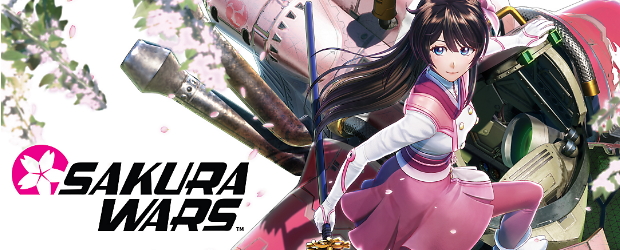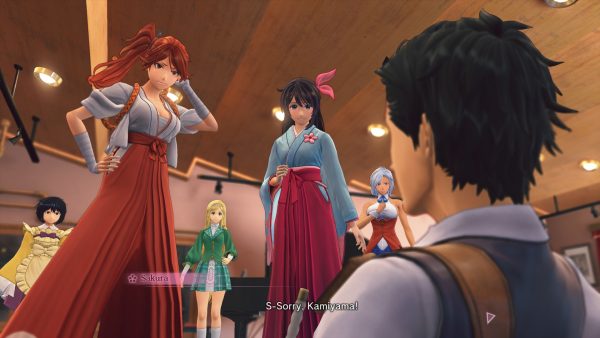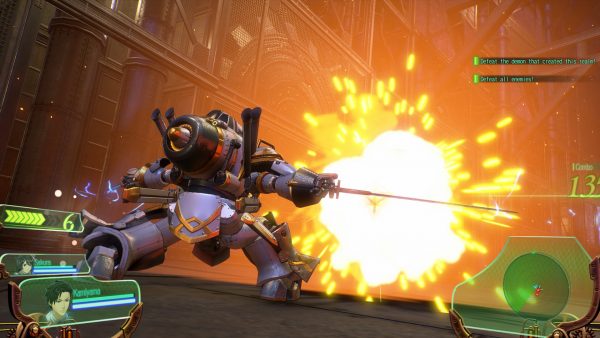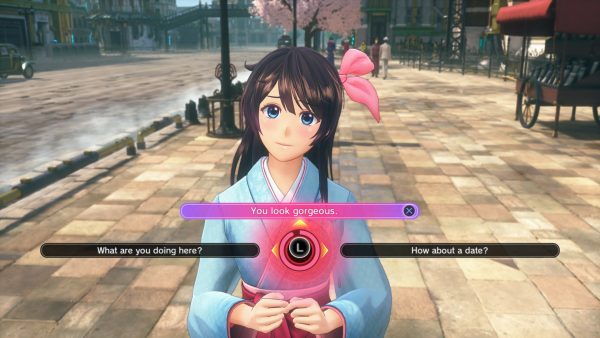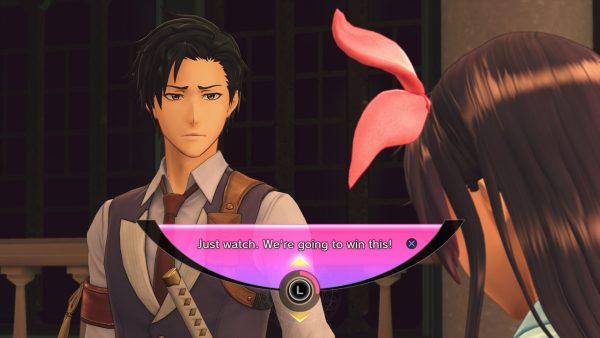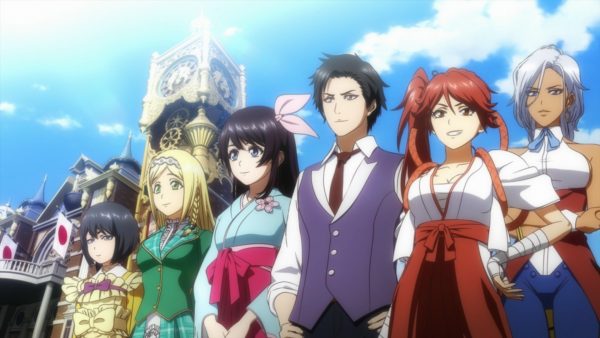After a long hiatus, the Sakura Wars series has finally returned. For many western gamers, this long-running franchise will likely be a mystery, since only Sakura Wars: So Long, My Love received an English release. Sakura Wars marks a new beginning for the series, featuring a new cast and a story that requires next to no knowledge of the previous games. For our review, both me and Francesco will give our thoughts on each aspect of the game.
Story
Isaac: Sakura Wars takes place after the fifth entry in the series, set in a steampunk version of 1940s Tokyo. The Great Demon War, an event taking place 10 years prior to the story, caused the Combat Revues of the previous games to disappear alongside the demons. Now the Imperial Theater of Tokyo is home to the new Imperial Combat Division, a group that is struggling to live up to their predecessor’s legacy. Ex-Navy captain Seijuro Kamiyama is assigned as the captain of this revue, and is tasked with bringing the Imperial Theater back to its former glory. He must work together with the five members of the theatre to both improve their performances on stage, and fight off the demons that have starter reappearing across Japan.
Most of the game’s story is spent focusing on the five heroines, who each get their own main chapter in the story. The main cast of Sakura Wars is small overall, and most supporting characters don’t get much time in the spotlight, but this doesn’t stop the regular slice of life scenes from being enjoyable. The game is at its best during its light-hearted moments, where Seijuro and the heroines can interact without the so-so story getting in the way. These moments offer a good amount of characterisation, as you learn more about each member of the Imperial Combat Revue.
The regular day to day encounters aren’t all great though. For starters, the writing likes to try and steer your choices towards perverted situations, such as a string of events involving the revue’s bathhouse. While you can skip these by choosing the right options, these less wholesome moment feel at odds with how Seijuro is portrayed normally. Despite some grievances with these optional events, the true weak link is the main story. After a decent start that gets you up to speed on the game’s setting, a constant string of predictable plot points and poorly paced story arcs ruin any chance at telling an engaging story. The last few chapters are particularly bad, as they try to wrap the story up quickly. This all leads to an unsatisfying ending that doesn’t hit the mark in any way.
Francesco: As far as the quality of the story itself goes, it’s certainly not a masterpiece. You can basically see all the “plot twists” coming, and near the ending it goes a bit all over the place trying to surprise you and it doesn’t spend enough time on each plot point. However, it is still enjoyable to go through thanks to the main heroines’ characterization. While they do tend to follow a few common tropes seen in anime-like games, they all still have their own unique charm and, as a result, make the whole story much more fun to go through.
Gameplay
Francesco: The gameplay is divided in 2 parts: an “everyday life + dating simulator” style and the actual fighting gameplay. The fighting resembles what you could see in a musou game: different combos using two buttons, plus a special move once the bar is full. Unfortunately, it’s way too easy and gets boring really fast. It gives the impression of something that was rushed because “there has to be gameplay in it”. There’s not even much choice in the characters, as you’ll be always forced to bring out Seijuro + one of the heroines, who is usually chosen by default. It’s not even that deep as you can simply mash buttons to win, and once you learn to spam the dodge button the bosses all become laughably easy.
The life simulator part was instead surprisingly fun. I usually tend to complain when visual novels drag dialogue too long, but here it works and there’s a lot of humour. You’ll get several dialogue options to choose from (and there will almost always be a perverted one that feels out of place), with the goal of increasing the trust of your partners to get them to perform better in battle. Unfortunately, that feature doesn’t quite work since, as I mentioned, the battles are way too easy. But it ironically gives a huge replayability incentive, just to see what kind of reaction a certain dialogue option would cause. There’s also no punishment in treating every girl the best you can, so you can worry about “who to choose” only when the actual choice happens. In the meantime, enjoy the ride.
Isaac: Of Sakura Wars‘ two halves, the adventure game/dating sim sections are by far the strongest. You’re able to run around the theatre and surrounding areas in Tokyo, with the handy map showing where there are viewable events. There’s little to outside of events, other than picking up collectable bromides of the main cast, but being able to explore freely makes the game’s world feel more alive. Events are also simple enough, as there’s usually limited interactivity. The most basic interaction is a set of dialogue choices that will sometimes pop up, letting you respond to a scene in multiple ways. Your choices will change your relationship with the heroines, and can often have some humorous results if you mess up. These choices are timed, and not answering can sometimes be the right option which is surprising. It does suffer from the problem this system has in most games, where the text doesn’t quite match the actual response Seijiro gives, but it’s easy enough to reload your last save and try again.
There are a few other ways you can interact with the cast, though in the end they don’t change things up too much. One type of dialogue choice let’s you choose the intensity of your response instead of the words. It’s not used often, and most of the time the right choice is obvious, but it’s another source of funny interactions if you choose poorly. Some more intimate scenes with the heroines also have you choosing conversations by interacting with the environment or the heroine herself, and it can lead so some touching moment. It’s a shame that these scenes can also be somewhat poorly written too, thanks to the forced romance that often feels out of place.
If Sakura Wars was only made up of the adventure segments, it would have been a solid enough title, even taking into account some missteps here and there. Unfortunately, the combat sections really drag the game down as a whole. Instead of using a serviceable turn-based battle system, the real time ‘Warriors’ style gameplay here is way too repetitive. The basic set of regular and heavy attacks only allows for a limited set of combos, and you’ll just spam the same ones over and over again. You’ll occasionally be able to use a special move once you fill a meter, but for some reason there’s a cutscene that plays every time before the attack goes off. It’s skippable, but why it’s there in the first place is a mystery. There’s also a once-per-level union attack that can clear the screen of enemies, though it feels tacked on rather than an interesting addition.
Even though these segments are brief, and only a small part of the game overall, they become boring incredibly quickly. You smash through weak enemies with the same combos, in mostly linear environments that offer little visual variety. Even the small number of boss fights fail to break up the tedious battles, as most of them can be defeated in a single special attack. The most egregious mistake these sections make, however, is that there’s little connection to the Adventure sections. Most of the game is about the Imperial combat revue coming together as a team, but battles only feature half of the cast at most. It doesn’t help that Seijuro is by far the most balanced character, so there’s not much incentive to control anyone else.
Presentation
Francesco: The animated cutscenes all look great and the graphical style itself is really charming, with a 2.5D technique that makes it look like a live cartoon. I was honestly impressed by how good it looked the first time I booted up the game. On the actual fighting, they went with a more realistic style which while is fitting due to being in a completely different world and facing creepy monsters, it also isn’t that impressive to look at and shows the limitations of the engine. The soundtrack is also good to hear, although it doesn’t have a lot of tracks and you’ll tend hearing the same ones a lot. The Japanese dub is also greatly done, although I wish there was a lot more recorded dubbing than there is. The low budget unfortunately shows: there’s a lot of scenes where characters move their mouths without actual words being heard, then all of a sudden you hear them speak again. Making certain scenes unintentionally comical (which is a shame).
Isaac: This is a good looking game overall, with a few blemishes here and there. The main point of contention is the character models, due to the art style used. Most characters look close to their designs, though this ends up making many of the heroines’ faces look strange. It’s mainly the eyes, since they often look enormous compared to the rest of their facial features. This isn’t exactly uncommon for games using this type of art style, but it’s especially off-putting here. The same can’t be said for the animations though, as Sakura Wars features some of liveliest cutscenes you’ll even see in an adventure game. Each character has a wide variety of charming animations, giving each of them more personality than they would have had with the generic animations you see in a lot of other anime-style games.
A strong Japanese voice-over only improves things even more. The combination of impressive animation and impactful voice acting really makes Sakura Wars stand out from the crowd. It’s not enough to save the weak main story, though it makes the aforementioned day-to-day scenes that much better. It’s a shame that not all scenes are voiced. Again, this isn’t uncommon for games like this, it’s just more noticeable here when the quality of regular events is so high.
Unsurprisingly, the one area where the game’s visuals are lacking is the battle sequences. Attack animations and effects are fine, even if their impact is lost after a few minutes of button mashing, No, the problem is the actual levels. There are only a few different environment types, with the most used ones being the biggest offenders. These dull areas consist off bland industrial sections and ugly looking rocks, being completely at odds with the colourful stye of the game’s other half. Maybe it was a deliberate choice, though that doesn’t change the fact that it’s boring to look at.
Conclusion
Francesco: Sakura Wars was overall a very nice surprise to me: a soft-reboot that was very enjoyable to play. It’s a shame that the fighting parts were so underdeveloped, but I would have gladly played a full playthrough of this game with just dialogue in it. Which is a testament to how fun the everyday life portions of the game were. If you’re into the anime-like games and don’t mind dialogues (considering they’re the best part of the experience), I’d say to give this one a try whenever you can.
Isaac: Even with the enjoyable event scenes, it’s hard to fully recommend Sakura Wars. A predictable, and often awful, main story and subpar battle sections get in the way of the game’s stronger moments. If you can slog through Sakura Wars at its worst however, then you’ll be left to enjoy some light-hearted moments with the Imperial Combat Revue.



